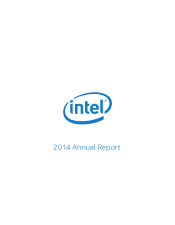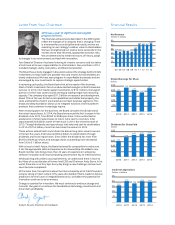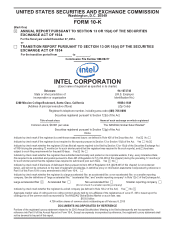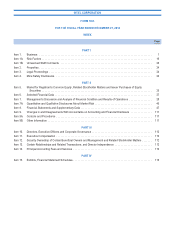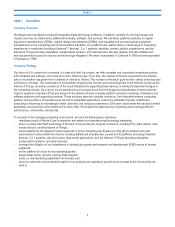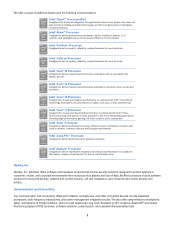Intel 2014 Annual Report Download - page 11
Download and view the complete annual report
Please find page 11 of the 2014 Intel annual report below. You can navigate through the pages in the report by either clicking on the pages listed below, or by using the keyword search tool below to find specific information within the annual report.Non-Volatile Memory Solutions
We offer NAND flash memory products primarily used in solid-state drives. Our NAND flash memory products are manufactured
by IM Flash Technologies, LLC (IMFT) and Micron Technology, Inc. (Micron).
Intel Custom Foundry
We offer manufacturing technologies and design services for our customers. Our foundry offerings include full custom silicon,
packaging, and manufacturing test services. We also provide semi-custom services to tailor Intel architecture-based solutions
with customers’ intellectual property blocks. To enable our customers to use our custom foundry services, we offer industry-
standard design kits, intellectual property blocks, and design services.
Products and Product Strategy by Operating Segment
Our PC Client Group operating segment offers products that are incorporated in notebook (including Ultrabook devices), 2 in 1
systems, and desktop computers for consumers and businesses. In 2014, we introduced the 5th generation Intel Core processor
family for use in 2 in 1 systems, and we will soon release the 5th generation Intel Core processors for other notebooks. These
processors use 14-nanometer (nm) transistors and our Tri-Gate transistor technology. Our Tri-Gate transistor technology extends
Moore’s Law by providing improved performance and energy efficiency. In combination, these enhancements can provide
significant power savings and performance gains when compared to previous-generation technologies.
Notebook
Our strategy for the notebook computing market segment is to offer notebook technologies designed to bring exciting new user
experiences to life and improve performance, battery life, wireless connectivity, manageability, and security. In addition, we are
designing for innovative smaller, lighter, and thinner form factors. We believe that our 5th generation Intel Core processors will
continue to deliver increasing levels of performance, graphics, and energy efficiency, and will provide our customers and end
users with multiple choices in operating system compatibility, processor cores, graphic performance, and battery life.
We have worked to help our customers develop a new class of personal computing devices that includes Ultrabook devices and
2 in 1 systems. These computers combine the energy-efficient performance and capabilities of today’s notebooks and tablets with
enhanced graphics and improved user interfaces such as touch and voice in a thin, light form factor that is highly responsive and
secure, and that can seamlessly connect to the Internet. In 2014, we introduced the Intel
®
Core™ M processor, our first
commercially available 14nm processor designed to enable responsive performance and improved battery life for new tablet-thin,
fanless devices. We believe the renewed innovation in the PC industry that we fostered with Ultrabook devices and expanded to
2 in 1 systems will continue.
Desktop
Our strategy for the desktop computing market segment is to offer exciting new user experiences and products that provide
increased manageability, security, and energy-efficient performance. We are also focused on lowering the total cost of ownership
for businesses. The desktop computing market segment includes all-in-one desktop products, which combine traditionally
separate desktop components into one form factor. Additionally, all-in-one computers have transformed into portable and flexible
form factors that offer users increased portability and new multi-user applications and uses. For desktop consumers, we also
focus on the design of products for high-end enthusiast PCs and mainstream PCs with rapidly increasing audio and media
capabilities.
Our Data Center Group operating segment offers products designed to provide leading energy-efficient performance for all
server, network, and storage platforms. In addition, the Data Center Group (DCG) focuses on lowering the total cost of ownership
and on other specific optimizations for the enterprise, cloud, communications infrastructure, and technical computing segments. In
2014, we launched our next-generation Intel Xeon processor E5 family platform for our 22nm process technology. The 22nm Intel
Xeon processors provide improved performance and better power consumption across server, network, and storage platforms.
We also launched our next-generation Intel Xeon processor E7 family. These products are targeted at platforms requiring four or
more CPUs and industry leading reliability, availability, and serviceability. DCG is continuing to ramp the Intel
®
Xeon Phi™
coprocessor with 60 or more high-performance, low-power Intel processor cores. The Intel Xeon Phi coprocessors are positioned
to boost the power of the world’s most advanced supercomputers, enabling trillions of calculations per second.
6

